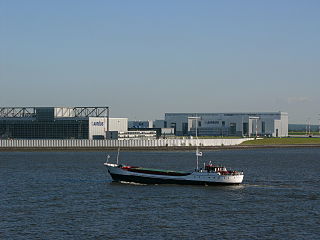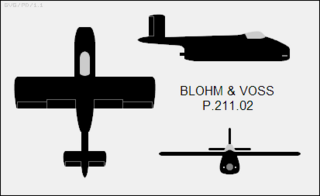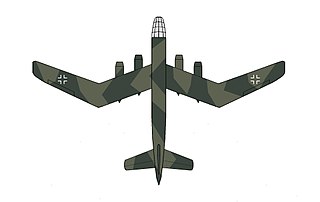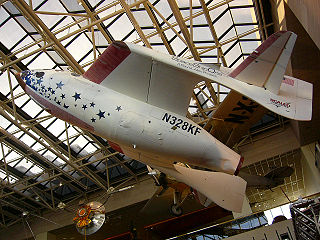Related Research Articles

Blohm+Voss (B+V), also written historically as Blohm & Voss, Blohm und Voß etc., is a German shipbuilding and engineering company. Founded in Hamburg in 1877 to specialise in steel-hulled ships, its most famous product was the World War II battleship Bismarck. In the 1930s, its owners established the Hamburger Flugzeugbau aircraft manufacturer which, shortly before the outbreak of World War II, adopted the name of its parent company. Following a difficult period after the war, B+V was revived, changing ownership among several owners, as Thyssen Group and Star Capital. In 2016, it became a subsidiary of Lürssen and continues to supply both the military and civilian markets. It serves two areas – new construction of warships as NVL B.V. & Co. KG, and new construction and refitting of megayachts. The company has been in operation, building ships and other large machinery, almost continuously for 146 years.
Hamburger Flugzeugbau (HFB) was an aircraft manufacturer, located primarily in the Finkenwerder quarter of Hamburg, Germany. Established in 1933 as an offshoot of Blohm & Voss shipbuilders, it later became an operating division within its parent company and was known as Abteilung Flugzeugbau der Schiffswerft Blohm & Voss from 1937 until it ceased operation at the end of World War II. In the postwar period it was revived as an independent company under its original name and subsequently joined several consortia before being merged to form Messerschmitt-Bölkow-Blohm (MBB). It participates in the present day Airbus and European aerospace programs.

The Hamburger Flugzeugbau Ha 137 was a German ground-attack aircraft of the 1930s. It was Blohm & Voss' entry into the contest to equip the re-forming Luftwaffe with its first purpose-built dive bomber. Although the contest would eventually be won by the Junkers Ju 87, the Ha 137 demonstrated that B&V's Hamburger Flugzeugbau, not even two years old at this point, had a truly capable design team of its own. One Ha 137 single-seat prototype competed against the Henschel Hs 123 at Rechlin.

The Emergency Fighter Program was the program that resulted from a decision taken on July 3, 1944 by the Luftwaffe regarding the German aircraft manufacturing companies during the last year of the Third Reich.

The Blohm & Voss Ha 142 was a German four-engined long-distance monoplane, developed to meet a Luft Hansa requirement for its transatlantic airmail service. The first of several prototypes flew on 11 October 1938 and they saw some service in other roles during the Second World War.
Transall was a consortium created to design and manufacture the Transall C-160 military transport aircraft.

Airbus Hamburg-Finkenwerder, also known as Hamburg Finkenwerder Airport, is an aircraft manufacturing plant and associated private airport in the Finkenwerder quarter of southwest Hamburg, Germany. The airport is an integral part of the Airbus-owned plant, and is exclusively used by that company for corporate, freight, test, and delivery flights, including those of the former Airbus A380.

Wenzendorf is a municipality in Lower Saxony, Germany. It is also the name of the chief village of the municipality.
Richard Vogt was a military German aircraft designer who was known for his original airframes, including the asymmetrical BV 141 during World War II. After the war, he moved to the United States as part of Operation Paperclip, where he worked on American military aircraft design.
The German Air Ministry had a system for aircraft designation which was an attempt by the aviation authorities of the Third Reich to standardize and produce an identifier for each aircraft design's airframe type produced in Germany. It was in use from 1933 to 1945 though many pre-1933 aircraft were included and the system had changes over those years. As well as aircraft of the Luftwaffe, it covered civilian airliners and sport planes, due to the RLM handing all aviation-related matters in the Third Reich, both civilian and military in nature.
The Hamburger Flugzeugbau Ha 136 was an all-metal, single-seat training monoplane. It was the first design for the company by Dr. Richard Vogt and the first to feature his trademark tubular steel wing spar which doubled as the main fuel tank. Two prototypes were built but it was not ordered into production.

The Blohm & Voss P 211 was a design proposal submitted by Blohm & Voss to the Volksjäger jet fighter competition of the Luftwaffe Emergency Fighter Program towards the end of the Second World War.

The Blohm & Voss P 213 was a submission to the Miniaturjäger programme of the Luftwaffe Emergency Fighter Program towards the end of the Second World War. The Miniaturjäger was to be powered by a pulse jet but the programme was scrapped in December 1944.

The Blohm & Voss Bv P 188 was a long-range, heavy jet bomber design project by the Blohm & Voss aircraft manufacturing division during the last years of the Third Reich. It featured a novel W-wing planform with variable incidence.

An outboard tail is a type of aircraft tail or empennage which is split in two, with each half mounted on a short boom just behind and outboard of each wing tip. It comprises outboard horizontal stabilizers (OHS) and may or may not include additional boom-mounted vertical stabilizers (fins). OHS designs are sometimes described as a form of tailless aircraft.
The Blohm & Voss P 214 was a small manned interceptor project described as a Bemannte Fla. Bombe, meaning "Manned Air Defence Bomb". It was studied late in 1944 but not developed past the project stage.
The Blohm & Voss P215 was an advanced jet night fighter project by Blohm & Voss during the Second World War. With a crew of three and twin jet engines, it featured a tailless swept-wing layout and heavy armament. An order for three prototypes was received just weeks before the war ended.
The Blohm & Voss P 163 was a design project for an unconventional bomber during World War II. Constructed mainly from steel, its crew were accommodated in large wingtip nacelles, giving it a triple-fuselage appearance. Its propeller drive system was also unusual, with the central fuselage containing twin engines coupled to a front-mounted contra-prop.
The Blohm & Voss Ae 607 was a jet-powered flying wing design drawn up by Blohm & Voss in 1945. Very little is known about it and its existence was only confirmed in 2017.
References
Citations
- ↑ Green 1979, p. 69.
- ↑ Cowin 1963, p. 312, Part I, October issue.
- ↑ Amtmann, Hans; "Blohm & Voss Remembered", Part I, Aeroplane Monthly, February 1998, pp.26-27.
- 1 2 Green 1979, pp. 70–71.
- 1 2 3 Green 1979, p. 71.
- ↑ Green 1979, p. 80.
- ↑ Green 1979, p. 78.
- 1 2 Green 1979, p. 92.
- 1 2 Green 1979, p. 96.
- 1 2 3 4 5 6 7 8 Green 1979, p. 75.
- ↑ Masters 1982, p. 26: "...known to have been intended as a shipborne fighter"
- ↑ Cowin 1963, pp. 404–5, Part III, December issue.
- ↑ Masters 1982, p. 27.
- 1 2 Masters 1982, p. 30.
- 1 2 Sharp 2017, p. 68.
- ↑ Sharp 2017, pp. 68, 73.
Bibliography
- Cowin, Hugh (October–December 1963). Blohm und Voss Projects of World War II, 'Air Pictorial', Parts I-III.
- Green, William (1979). Warplanes of the Third Reich (4th ed.). Macdonald and Jane's.
- Masters, David (1982). German Jet Genesis. Jane's.
- Sharp, Dan (2017). Luftwaffe: Secret Wings of the Third Reich. Mortons.